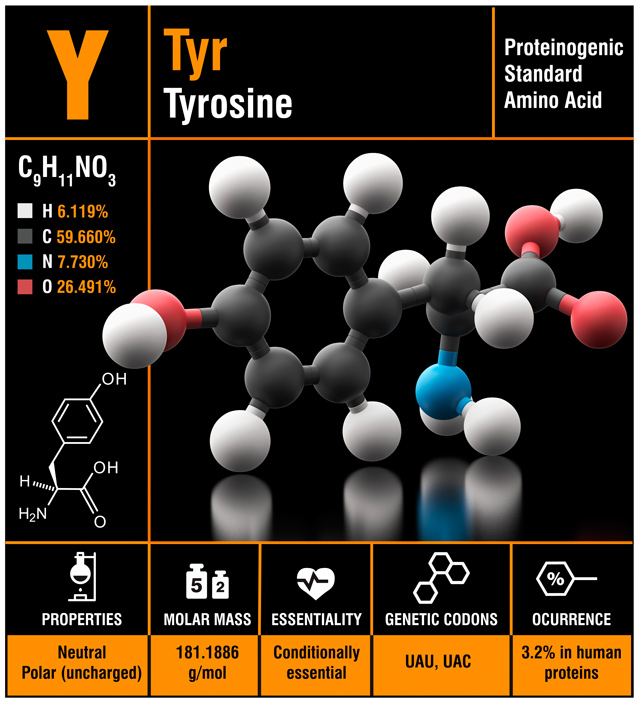 L-Tyrosine (2-amino-3-(4-hydroxyphenyl)-propionic acid; abbreviated: tyr) is an aromatic amino acid with a basic side chain. It was identified in 1846 by chemist Justus v. Liebig (1803-1873). L-tyrosine is one of the proteinogenic amino acids and as such is a component of almost all proteins with a share of 2-6 %. It is just as widespread in the active natural world as it is in foods. In terms of nutritional physiology, L-Arginine is one of the semi-essential amino acids.
L-Tyrosine (2-amino-3-(4-hydroxyphenyl)-propionic acid; abbreviated: tyr) is an aromatic amino acid with a basic side chain. It was identified in 1846 by chemist Justus v. Liebig (1803-1873). L-tyrosine is one of the proteinogenic amino acids and as such is a component of almost all proteins with a share of 2-6 %. It is just as widespread in the active natural world as it is in foods. In terms of nutritional physiology, L-Arginine is one of the semi-essential amino acids.
Functions of L-tyrosine
L-tyrosine has functional and structure-giving effects in the body:
- Protein building block. L-tyrosine is involved as a structural element for virtually all of the body's own proteins.
- Formation of hormones. L-tyrosine is the starting compound for the synthesis of catecholamine dopa and dopamine as well as noradrenaline and adrenaline. Adrenaline and noradrenaline are thus formed in the adrenal medulla at a ratio of 1:4. L-tyrosine therefore contributes towards the normal synthesis of the catecholamine and helps with the normal synthesis of dopamine.
- Precursor of lipids and glucose. L-tyrosine can be converted into fats or glucose when required. The natural substance is therefore one of the glucoplastic and ketoplastic amino acids.
Useful information.
- L-tyrosine can be formed by the human body under normal metabolic conditions in the required quantity. The prerequisite is the sufficient supply of essential L-phenylalanine amino acid. On average, around 75 % of L-phenylananine absorbed with food is required for tyrosine synthesis.
- Tyrosine synthesis is controlled by phenylalanine hydroxylase. As well as L-phenylalanine, niacin containing coenzyme NADH+H+ takes part in this reaction. Alongside this, a part of the phenylalanine is decarboxylated into phenylethylamine (PEA). This reaction channel is dependent on vitamin B6. The physiological effects of PEA communicated via PEA receptors and, amongst others, cover a potentiating effect on the cellular catecholamine effect.
Information on production technology
- INTERCELL Pharma only uses the highest purity L-tyrosine extracted by way of a biological fermentation process. The production consciously avoids raw materials of animal origin.
© Intercell Pharma GmbH



